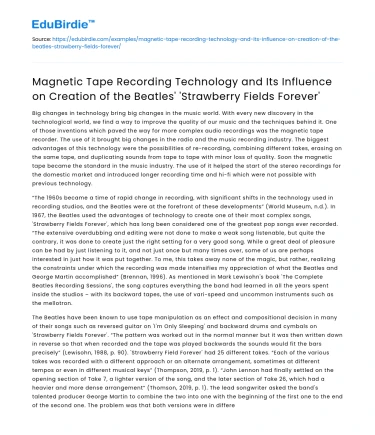Big changes in technology bring big changes in the music world. With every new discovery in the technological world, we find a way to improve the quality of our music and the techniques behind it. One of those inventions which paved the way for more complex audio recordings was the magnetic tape recorder. The use of it brought big changes in the radio and the music recording industry. The biggest advantages of this technology were the possibilities of re-recording, combining different takes, erasing on the same tape, and duplicating sounds from tape to tape with minor loss of quality. Soon the magnetic tape became the standard in the music industry. The use of it helped the start of the stereo recordings for the domestic market and introduced longer recording time and hi-fi which were not possible with previous technology.
“The 1960s became a time of rapid change in recording, with significant shifts in the technology used in recording studios, and the Beatles were at the forefront of these developments” (World Museum, n.d.). In 1967, the Beatles used the advantages of technology to create one of their most complex songs, 'Strawberry Fields Forever', which has long been considered one of the greatest pop songs ever recorded. “The extensive overdubbing and editing were not done to make a weak song listenable, but quite the contrary, it was done to create just the right setting for a very good song. While a great deal of pleasure can be had by just listening to it, and not just once but many times over, some of us are perhaps interested in just how it was put together. To me, this takes away none of the magic, but rather, realizing the constraints under which the recording was made intensifies my appreciation of what the Beatles and George Martin accomplished” (Brennan, 1996). As mentioned in Mark Lewisohn's book 'The Complete Beatles Recording Sessions', the song captures everything the band had learned in all the years spent inside the studios – with its backward tapes, the use of vari-speed and uncommon instruments such as the mellotron.
Save your time!
We can take care of your essay
- Proper editing and formatting
- Free revision, title page, and bibliography
- Flexible prices and money-back guarantee
The Beatles have been known to use tape manipulation as an effect and compositional decision in many of their songs such as reversed guitar on 'I'm Only Sleeping' and backward drums and cymbals on 'Strawberry Fields Forever'. “The pattern was worked out in the normal manner but it was then written down in reverse so that when recorded and the tape was played backwards the sounds would fit the bars precisely” (Lewisohn, 1988, p. 90). 'Strawberry Field Forever' had 25 different takes. “Each of the various takes was recorded with a different approach or an alternate arrangement, sometimes at different tempos or even in different musical keys” (Thompson, 2019, p. 1). “John Lennon had finally settled on the opening section of Take 7, a lighter version of the song, and the later section of Take 26, which had a heavier and more dense arrangement” (Thomson, 2019, p. 1). The lead songwriter asked the band's talented producer George Martin to combine the two into one with the beginning of the first one to the end of the second one. The problem was that both versions were in different keys and tempos so the producer had to think of a way of merging them in a pleasing to the listener's ear way. George and the sound engineer Geoff Emerick had to work on a solution to that issue. They found out that if they speeded up the first part and slowed down the second, they might match. “We gradually decreased the pitch of the first version at the join to make them weld together”, says Geoff Emerick (Lewisohn, 1988, p. 91).
The artistic practices used by the Beatles were only made possible because of the revolutionary magnetic tape recorder which proves what an impact such invention can make in the music world. With previous technologies, extensive overdubbing, reversing and fusing two different versions of a song into one would have not been possible. The band's artistic demands pushed the 1960s recording technology to its boundaries and created a masterpiece that connected art and technology. The magnetic tape recorder was an invention that brought a lot of possibilities, but it was the Beatles' creativity which shaped music as we know it.
References
- Lewisohn, M. (1988). The Beatles Recording Sessions. The Official Abbey Road Studio Session Notes 1962-1970. New York: Harmony Books.
- World Museum. (n.d.). The Beatles and Multitrack Recording. Retrieved from https://www.liverpoolmuseums.org.uk/wml/exhibitions/thebeatgoeson/thebeatgoesonline/technology/studios/beatles.aspx
- Thompson, P. (2019) Creativity in the Recording Studio: Alternative Takes. Retrieved from https://books.google.co.uk/
- Brennan, J (1996). Strawberry Fields Forever: Putting Together the Pieces. Retrieved from http://www.columbia.edu/
- The Beatles. (1967). Strawberry Fields Forever. On Magical Mystery Tour [7-inch record]. Parlophone.
- Tape Recorded. (n.d.) In Wikipedia. Retrieved from https://en.wikipedia.org/wiki/Tape_recorder






 Stuck on your essay?
Stuck on your essay?

